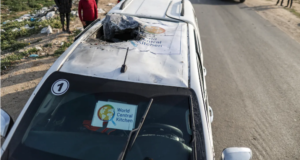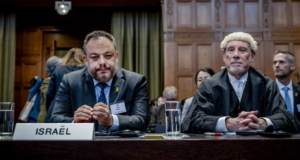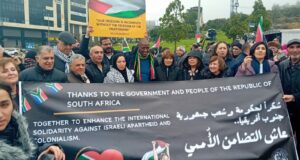by Nathan Stuckey
19 January 2012
Every Tuesday we gather next to the half destroyed Beit Hanoun Agricultural College. At eleven o’clock, we set out into the no go zone. This week there were about thirty of us, members of the Beit Hanoun Local Initiative, the International Solidarity Movement, and other activists from Gaza. At eleven o’clock the megaphone starts to play Bella Ciao and the flags are hoisted in the air, soon we start to march down the road into the no go zone. Today feels strange, something is different, there is only one body in the sky, the Israeli blimp that constantly hangs over Beit Hanoun watching our every move is missing, today only the sun is over us in the sky, the sun and some Israeli F16’s.
Entering the no go zone is always a strange experience. First, you always remember the danger, Israel claims the right to shoot anyone who enters the no go zone, every week, someone is shot for doing what we are doing. They are shot for going to their land, sometimes to gather cement to rebuild the houses shattered during the massacre the Israeli’s call Cast Lead, sometimes searching for metal to recycle and sell for a few shekels, sometimes shepherds with their sheep. The no go zone is like a dystopian future, the people who used to live there have all been expelled, they live as internal refugees in the prison that is Gaza. When you walk in the no go zone you are sometimes reminded that people used to live here, you find shredded irrigation pipes, wells, the foundations of houses, and today, for the first time, I saw an old quarry that used to provide rocks for building. The orchards and fields that used to cover the no go zone have been thoroughly erased, there is no more evidence that they even existed. In 1948 the Zionists plant forests to hide the ethnically cleansed Palestine villages, in Gaza, they do not bother, they just grind the evidence up under the treads of bulldozers. The orchards have already disappeared, there is no trace of them, most of the houses have disappeared, with time even the wells and the remaining foundations will slowly be ground to nothing. Only the quarry will remain. The land here is not like the rest of Gaza, walking is difficult, the bulldozers have left it completely scarred, jagged mini hills and ridges are everywhere.
Today, we walk deep into the no go zone. Deeper than we have ever gone before, to land no Palestinian has been on since 2000. Sometimes it feels like a nature walk, instead of watching out for tigers or lions we watch out for jeeps or tanks. We finally reach the barbed wire that lays about 20 meters in front of the wall, there is no way through it. A smaller balloon than the usual one begins to rise over the wall. Sabur Zaaneen from the Beit Hanoun Local Initiative speaks, “We would like to welcome all of the activists who have to come to Gaza with the Miles of Smiles Convoy, I hope that many more activists come to Palestine to work in the towns and refugee camps of Palestine where they can confront the state terrorism of Israel directly.” We climb a nearby hill and plant a flag. We spot a jeep; it drives up to the concrete tower embedded in the wall. The soldiers climb the stairs and begin to shoot at us. We begin to walk back to Beit Hanoun. The soldiers climb down from the tower, get in their jeep and drive to higher hill overlooking the no go zone. They get out, and aim their guns at us again. It does not matter that they are under no threat, that we are a completely nonviolent demonstration of civilians on their own land. In Gaza, the occupation is reduced to its most basic, the tracks of bulldozers and the crack of rifles. The bulldozers erase all evidence that anybody ever lived there, the rifles erase the people that live here. We will not be erased. The olive trees that we plant in the no go zone will feed the children of Gaza. The martyrs will live on in our hearts. The popular resistance will outlast the occupation.
 International Solidarity Movement Nonviolence. Justice. Freedom.
International Solidarity Movement Nonviolence. Justice. Freedom.


